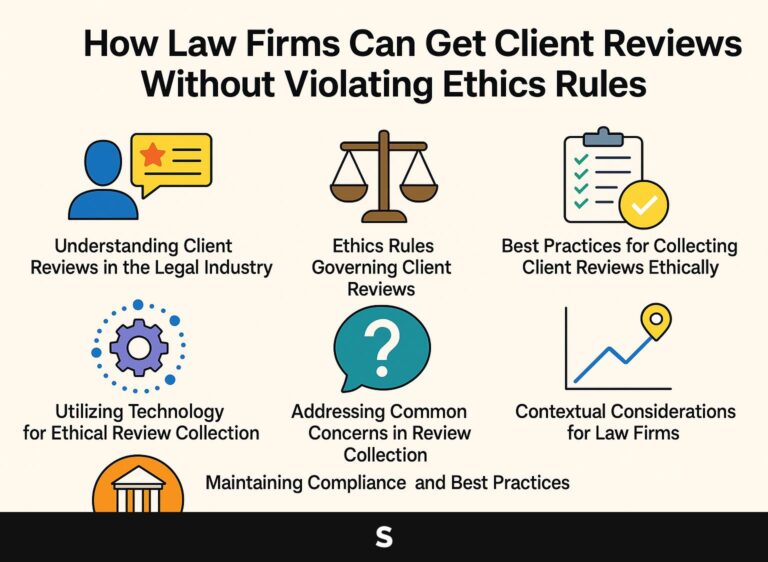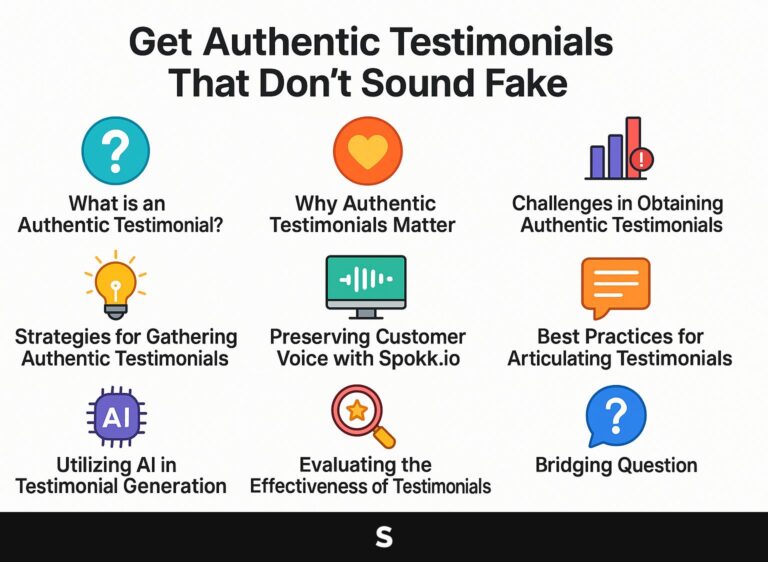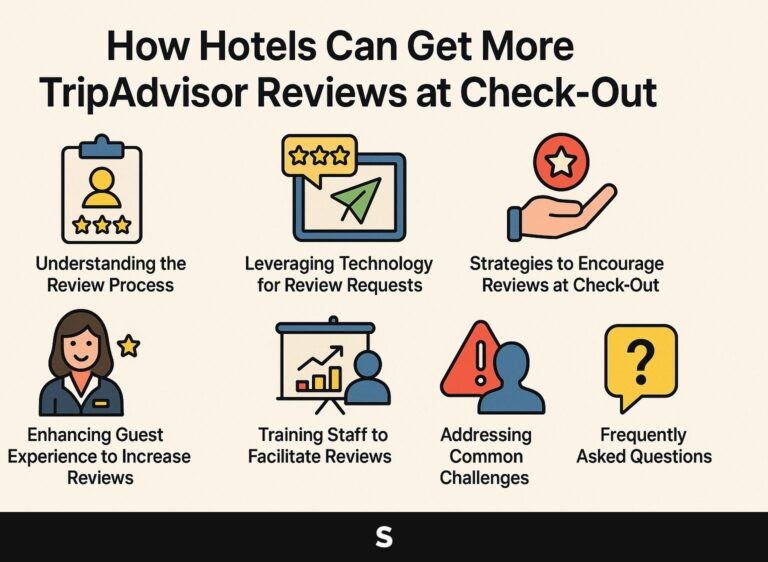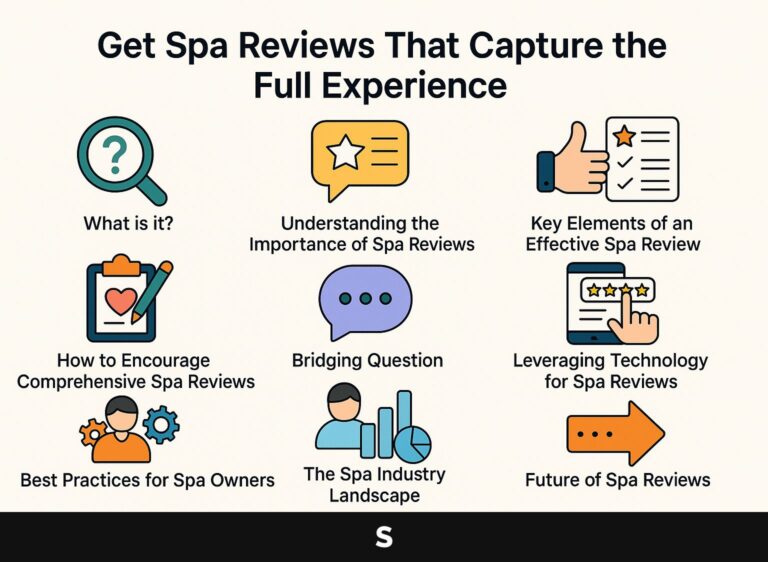Build Trust with Reviews That Address Common Customer Concerns
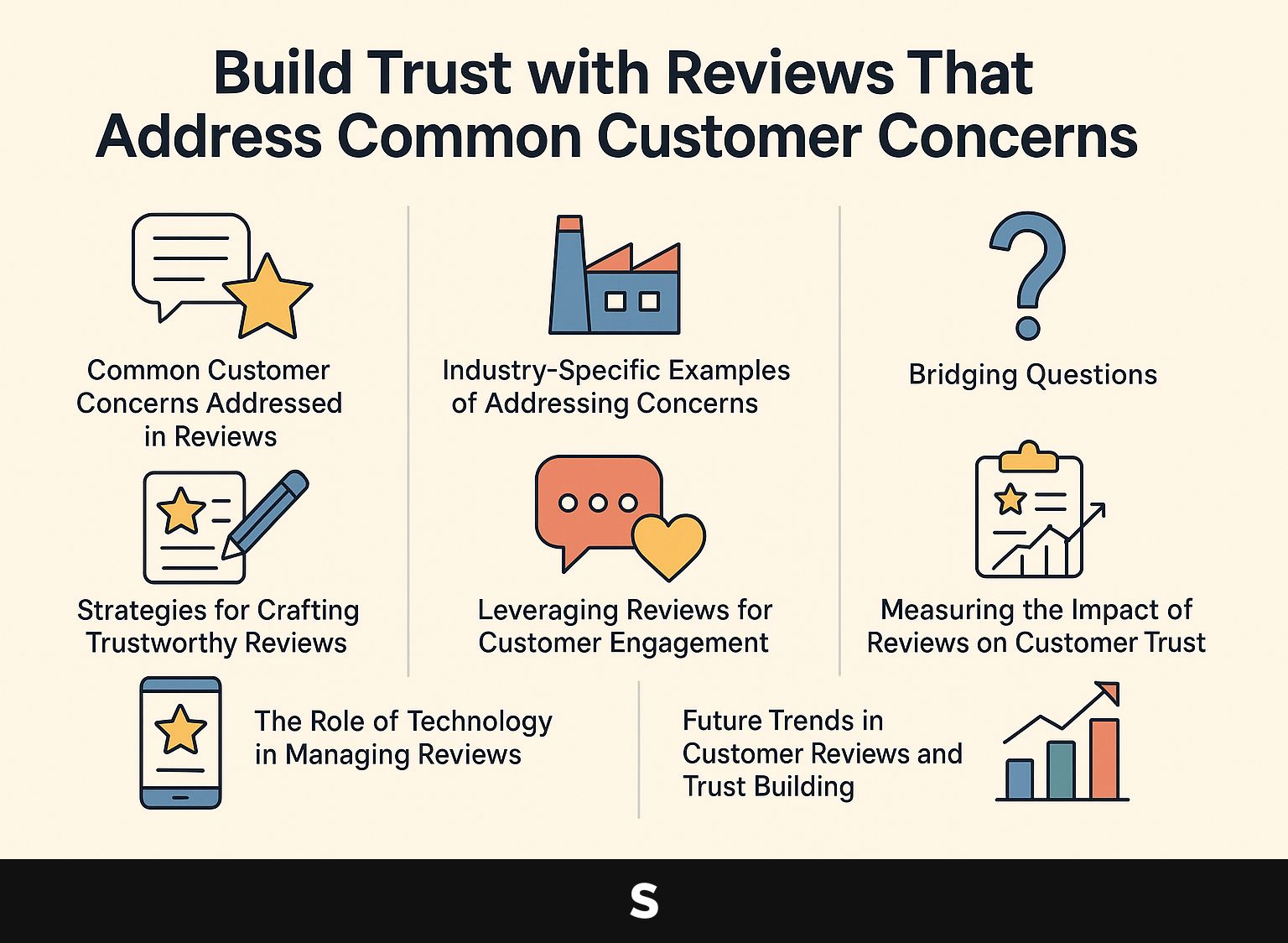
In today’s competitive online market, earning the trust of potential buyers is essential. Many shoppers hesitate, concerned about product quality and service reliability. By using focused reviews that tackle typical concerns-such as careful handling for movers or pain-free experiences for dentists-brands can reassure potential customers. This article will discuss practical methods for creating customer feedback that showcases excellent products and improves your customer service image, helping to build trust in your online store.
Key Takeaways:
- Build Trust with Reviews That Address Common Customer Concerns
- Common Customer Concerns Addressed in Reviews
- Industry-Specific Examples of Addressing Concerns
- Bridging Question
- Ways to Write Honest Reviews
- Using Feedback to Connect with Customers
- Measuring the Impact of Reviews on Customer Trust
- **Using Technology to Handle Reviews** Technology plays an important part in handling reviews. It helps businesses collect, analyze, and respond to feedback promptly. With tools like automated response systems and emotion analysis, companies can improve customer satisfaction and make informed decisions. These tools allow businesses to easily monitor customer opinions. **Why It’s Necessary** Managing reviews well can strengthen customer relationships and improve reputation. With the right tools, businesses can quickly address issues and show customers their opinions matter. This can lead to greater loyalty and repeat customers. **How It Works** 1. **Gathering**: Technology collects reviews from different platforms and combines them. 2. **Analysis**: It checks the feedback to find common topics and emotions. 3. **Replying**: Automated systems help businesses respond to reviews quickly and accurately. **Advantages** – **Time-Saving**: Cuts down the time and effort needed to handle reviews. – **Accurate**: Provides detailed knowledge of customer opinions. – **Customer Interaction**: Encourages positive engagement with customers through timely responses. **Summary** In today’s market, using technology to handle reviews is important for maintaining good customer relations and improving business operations.
- “Upcoming Developments in Customer Feedback and Building Trust”
- Frequently Asked Questions
- How can I use reviews to build trust with potential customers?
- How does Spokk.io’s AI understand industry-specific concerns?
- What types of concerns can Spokk.io’s AI address in reviews?
- Can addressing concerns in reviews help set my business apart from competitors?
- Is it important to address concerns in reviews for different industries?
- How can Spokk.io’s AI help me reassure potential customers in reviews?
Build Trust with Reviews That Address Common Customer Concerns
Customer reviews are important for building trust in businesses because they provide real feedback that deals with what customers care about and expect. For an extensive analysis of this trend, our comprehensive study of customer feedback management examines crucial strategies for leveraging customer insights effectively.
What are customer reviews and why are they important?
Customer reviews are feedback from buyers that give information about their experiences with products or services. They are important for building trust.
These reviews are clearly shown on websites like Google Reviews, Yelp, and Trustpilot, where people often look for information before buying.
Positive reviews can greatly improve a brand’s reputation, leading new customers to trust the product. Conversely, negative reviews can damage credibility, leading to lost sales and a tarnished image.
Businesses can mitigate this by actively responding to feedback-addressing concerns and thanking customers for positive comments-thereby demonstrating their commitment to customer satisfaction.
How do reviews influence customer trust?
Reviews significantly influence customer trust by serving as social proof; they provide customers with reassurance that their buying decisions are validated by fellow consumers.
In fact, a study by BrightLocal revealed that 70% of consumers trust online reviews as much as personal recommendations. Creating a strong review system can greatly improve trustworthiness.
For instance, a restaurant that added customer reviews to its homepage saw a 30% increase in reservations within three months.
Tools like Yotpo or Trustpilot can help businesses easily gather and display reviews, enabling potential customers to see positive feedback prominently.
Posting these reviews on social media can make them more influential, helping others decide to buy.
Common Customer Concerns Addressed in Reviews
Many customer worries come from doubts about how good the service is, the cost, and how dependable the product is.
These worries can be handled well with carefully written reviews, as highlighted in examples of positive reviews.
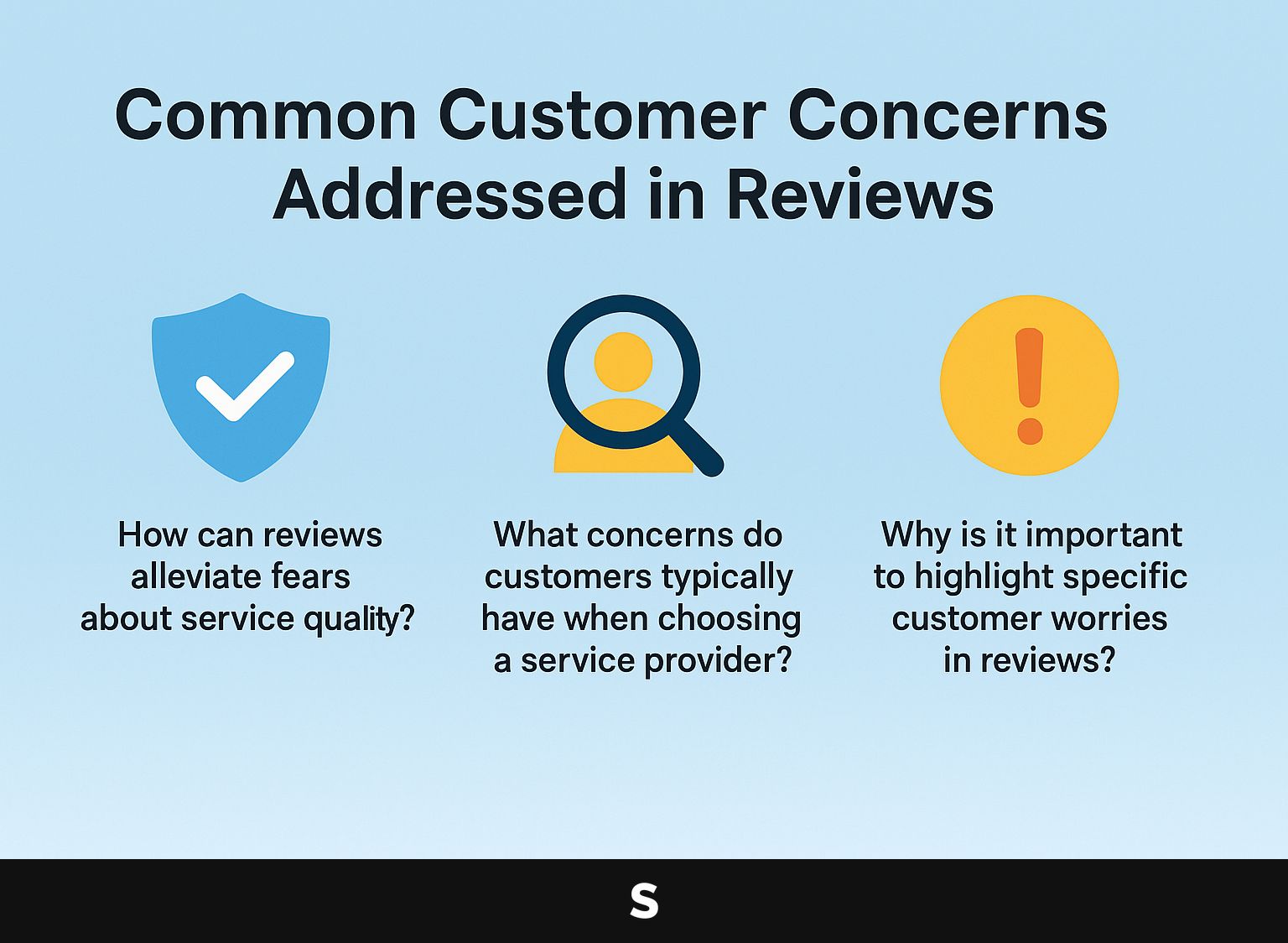
How can reviews alleviate fears about service quality?
Reviews that emphasize a consistent quality of service can alleviate fears by showcasing authentic customer experiences that reflect reliability and professionalism.
Using certain phrases can make reviews more believable. For instance, mentioning ‘padding’ suggests that items were protected during transport, which reassures buyers about their fragile items.
Similarly, discussing ‘fragile item handling’ communicates to potential customers that care was taken to prevent damage. Pointing out ‘insurance coverage’ helps reassure clients that they are protected against possible losses.
When these terms are used, reviews can help build trust, increasing belief in the service being reviewed.
What concerns do customers typically have when choosing a service provider?
Common concerns include pricing transparency, quality assurance, and responsiveness, which can all be addressed through targeted reviews that speak directly to these issues.
To effectively tackle these concerns in reviews, consider highlighting specific aspects.
-
For pricing transparency, mention if the business provides detailed breakdowns of costs.
-
For quality assurance, provide examples of customer experiences or product longevity.
-
For responsiveness, point out the average wait times for customer service or how quickly issues were resolved.
Businesses should encourage reviewers to focus on these elements, ensuring potential customers feel informed and confident in their purchasing decisions.
Why is it important to highlight specific customer worries in reviews?
Highlighting specific customer worries in reviews is essential as it directly addresses potential objections, thus allowing prospective customers to feel understood and valued.
For instance, a skincare company could include reviews that acknowledge concerns about product effectiveness on sensitive skin.
A customer might write, “I was unsure because of my allergies, but this cream was effective without causing any irritation.” This feedback helps build confidence, as new buyers see that their concerns are noticed and resolved by others.
Companies like Amazon and Trustpilot have used this strategy well, showing a clear rise in conversion rates when genuine issues are openly talked about in reviews.
Industry-Specific Examples of Addressing Concerns
Different industries encounter specific customer issues that reviews can effectively solve, building trust and reliability in various service areas, especially when enhancing customer experience is a priority. For instance, in the retail sector, enhancing the customer experience involves tailored strategies that directly address and resolve consumer concerns.
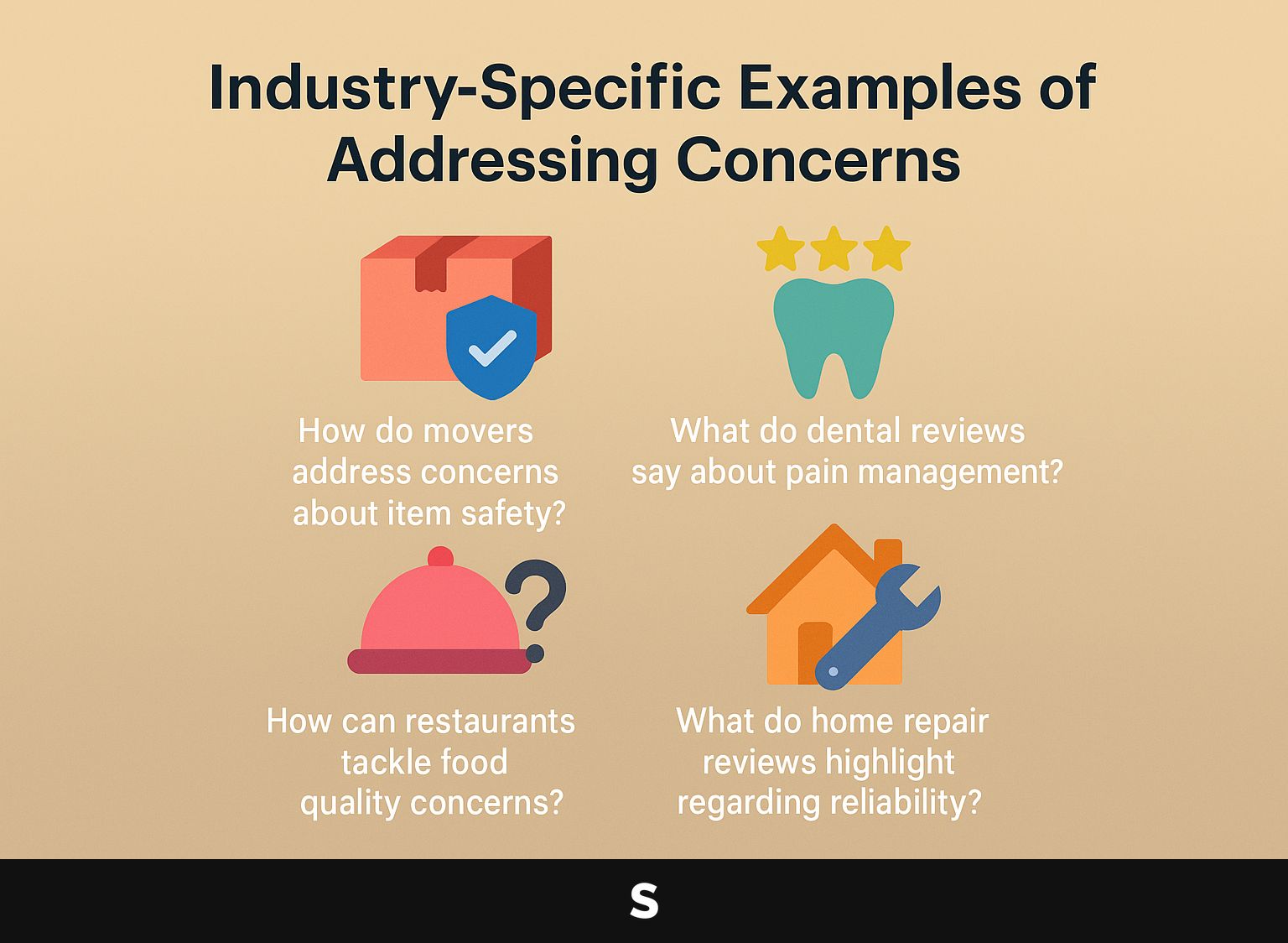
How do movers address concerns about item safety?
Movers tackle item safety concerns by emphasizing their use of protective materials and careful handling during transit, which can be showcased in customer reviews.
Specific phrases in customer reviews can significantly reassure potential clients. Terms like ‘padding’ should be used to highlight that movers use cushioning for fragile items, while ‘fragile item handling’ communicates a commitment to careful transport of delicate goods.
Mention of ‘insurance coverage’ serves to alleviate any fears about potential damage. For instance, a review stating, ‘My vintage china was carefully padded and handled, and I felt at ease knowing they had insurance coverage for any mishaps,’ can strongly influence customer decisions.
What do dental reviews say about pain management?
Dental reviews often focus on pain management, providing assurance to anxious patients about the quality of care and comfort during procedures.
Many positive reviews focus on how sedation methods greatly improve patient experiences.
Patients often mention that nitrous oxide helps them relax during minor surgeries, making the process feel effortless. In the same way, people who chose IV sedation say they feel totally calm and without pain, and they wake up with little to no recall of the procedure.
Choosing a dental practice that prioritizes these methods can lead to a more comfortable, reassuring visit, helping to build trust among anxious patients.
How can restaurants tackle food quality concerns?
Restaurants can address food quality concerns by encouraging reviews that highlight freshness, ingredient sourcing, and presentation, creating transparency for potential diners.
To help customers write good reviews, restaurants can use specific suggestions. For example, they might ask, “How fresh were your ingredients?” or “How did the presentation improve your dining experience?”
Offering a brief survey post-meal with questions on ingredient sourcing can lead to more detailed feedback. Restaurants such as Farm-to-Table Bistro have noticed an increase in detailed reviews after using these suggestions, highlighting the benefits of getting customers to pay attention to quality features.
What do home repair reviews highlight regarding reliability?
Home repair reviews frequently emphasize reliability, detailing punctuality and professionalism, which are critical factors for customers looking for trustworthy service providers.
To choose a trustworthy home repair service, ask for references and read online reviews. Reliable services often have a solid presence on platforms like Yelp or Angie’s List.
Look for contractors who provide detailed estimates and clear communication. A good practice is to request a timeline for project completion; reliable providers will offer realistic schedules.
Verify that they are licensed and insured, as this assures accountability and protects your investment.
Bridging Question
Proactively gathering customer feedback is essential for businesses that wish to stay aligned with their customers’ needs and expectations.
To effectively gather feedback, consider employing a combination of methods.
Surveys are a powerful tool; use platforms like SurveyMonkey or Google Forms to create concise questionnaires. Making follow-up calls can make interactions more personal and help you learn more about what customers think. Monitor social media channels for real-time input.
Regularly analyze the collected data to identify trends and areas for improvement. When you make changes from this feedback, you demonstrate to customers that their views matter, creating loyalty and trust in your brand.
Ways to Write Honest Reviews
Creating honest reviews needs clear steps to guarantee accuracy and gain customer trust.
What elements make a review credible and trustworthy?
Key elements that contribute to a review’s credibility include detailed descriptions, authenticity, and the use of verified customer status.
To make reviews more trustworthy, businesses should ask reviewers to add details like user profiles, the date and time of the experience, and detailed descriptions of the product’s features.
For instance, instead of vague praise, a review might detail how a software tool improved productivity by 30%, backed by a screenshot of analytics.
Requesting reviews on platforms like Trustpilot or Google My Business can provide a verified status, assuring potential customers of the review’s authenticity. This organized method helps gain trust and shows potential clients real experiences.
How can businesses encourage honest reviews from customers?
Getting honest reviews means businesses need to create an environment where customers feel comfortable and are encouraged to share their true opinions.
- Send custom follow-up emails to customers after they buy something, asking them to tell about their experiences.
- Introducing a loyalty program can incentivize reviews; for instance, offer discounts or exclusive access for those who leave feedback.
- Use platforms like SurveyMonkey or Google Forms to create simple feedback channels, allowing both positive and negative comments.
- Show your customers that their opinions matter by replying to reviews. This starts a conversation and encourages more feedback later.
What role does transparency play in building trust through reviews?
Being open about how reviews are handled helps customers trust businesses. It shows them clearly how their opinions are taken into account and used.
Regularly replying to reviews can greatly increase customer loyalty. When a customer gives feedback, whether good or bad, businesses should respond quickly.
For instance, if a customer highlights an issue with service speed, a company might respond with an apology and mention specific steps they’ve taken to improve, like hiring additional staff or upgrading their software.
Establishing a feedback loop, where you periodically survey customers for their opinions on new initiatives or products, further demonstrates that their voice matters and can lead to better-informed business practices.
Using Feedback to Connect with Customers
Using reviews well helps increase customer interaction, letting businesses connect with their audience and build trust.
How do businesses respond to reviews to build trust?
Businesses build trust by responding to reviews in a timely and professional manner, demonstrating their commitment to customer satisfaction.
To effectively address reviews, create a response template.
For positive feedback, express gratitude and invite further engagement:
“Thank you for your kind words! We’re thrilled you enjoyed your experience. Please visit us again soon!”
For negative reviews, acknowledge the concern and offer a solution:
“We appreciate your feedback and regret that we fell short. Please contact us at [email] so we can resolve this issue.”
By tailoring your replies, you strengthen customer connections and demonstrate that their feedback matters.
What platforms are best for showcasing customer reviews?
Some platforms that show customer reviews well are Google, Facebook, and specific sites like Angie’s List or TripAdvisor, each catering to different types of businesses.
Google is essential for local businesses, attracting consumers actively searching for services, while Facebook reaches a broader social audience, facilitating customer interaction through comments and shares.
Unlike others, Angie’s List focuses on home services, providing detailed reviews and ratings specifically for local contractors. TripAdvisor is ideal for hospitality and travel-related businesses, focusing on user-generated content.
When selecting a platform, businesses should consider their target demographic and industry to maximize engagement and credibility-assessing which platform their audience frequents most often.
Measuring the Impact of Reviews on Customer Trust
Checking how reviews affect customer trust means looking at specific measurements that show how customers feel and act.
What metrics can businesses use to evaluate trust levels from reviews?
Businesses can evaluate trust levels from reviews through metrics such as Net Promoter Score (NPS) and Customer Satisfaction Score (CSAT).
-
To effectively calculate NPS, ask customers how likely they are to recommend your product on a scale from 0 to 10. Subtract the percentage of detractors (0-6) from promoters (9-10) to obtain your score.
-
To measure CSAT, ask customers a simple questionHow happy are you with your experience?” Use a 1-5 scale and calculate the average score.
By closely monitoring these metrics, companies like Amazon have fine-tuned their services, leading to higher customer loyalty and satisfaction.
How can businesses track changes in customer perception over time?
Tracking changes in customer perception over time involves regular analysis of review data and customer feedback trends to identify shifts in sentiment.
To keep track of these changes, use tools like Google Analytics to understand visitor behavior and platforms like ReviewTrackers or Trustpilot to collect customer feedback.
Set up regular review audits, perhaps on a monthly basis, to analyze both quantitative metrics and qualitative comments. This could involve categorizing feedback, identifying common themes, and comparing changes over time.
Keep track of results to spot patterns, allowing you to address issues quickly and make customers happier, which improves your brand’s reputation.
**Using Technology to Handle Reviews** Technology plays an important part in handling reviews. It helps businesses collect, analyze, and respond to feedback promptly. With tools like automated response systems and emotion analysis, companies can improve customer satisfaction and make informed decisions. These tools allow businesses to easily monitor customer opinions. **Why It’s Necessary** Managing reviews well can strengthen customer relationships and improve reputation. With the right tools, businesses can quickly address issues and show customers their opinions matter. This can lead to greater loyalty and repeat customers. **How It Works** 1. **Gathering**: Technology collects reviews from different platforms and combines them. 2. **Analysis**: It checks the feedback to find common topics and emotions. 3. **Replying**: Automated systems help businesses respond to reviews quickly and accurately. **Advantages** – **Time-Saving**: Cuts down the time and effort needed to handle reviews. – **Accurate**: Provides detailed knowledge of customer opinions. – **Customer Interaction**: Encourages positive engagement with customers through timely responses. **Summary** In today’s market, using technology to handle reviews is important for maintaining good customer relations and improving business operations.
Technology is key in handling reviews, helping businesses look at customer feedback more easily and quickly. For a deeper understanding, consider how technology revolutionizes the customer experience, exploring its full impact on feedback management in this related callout.
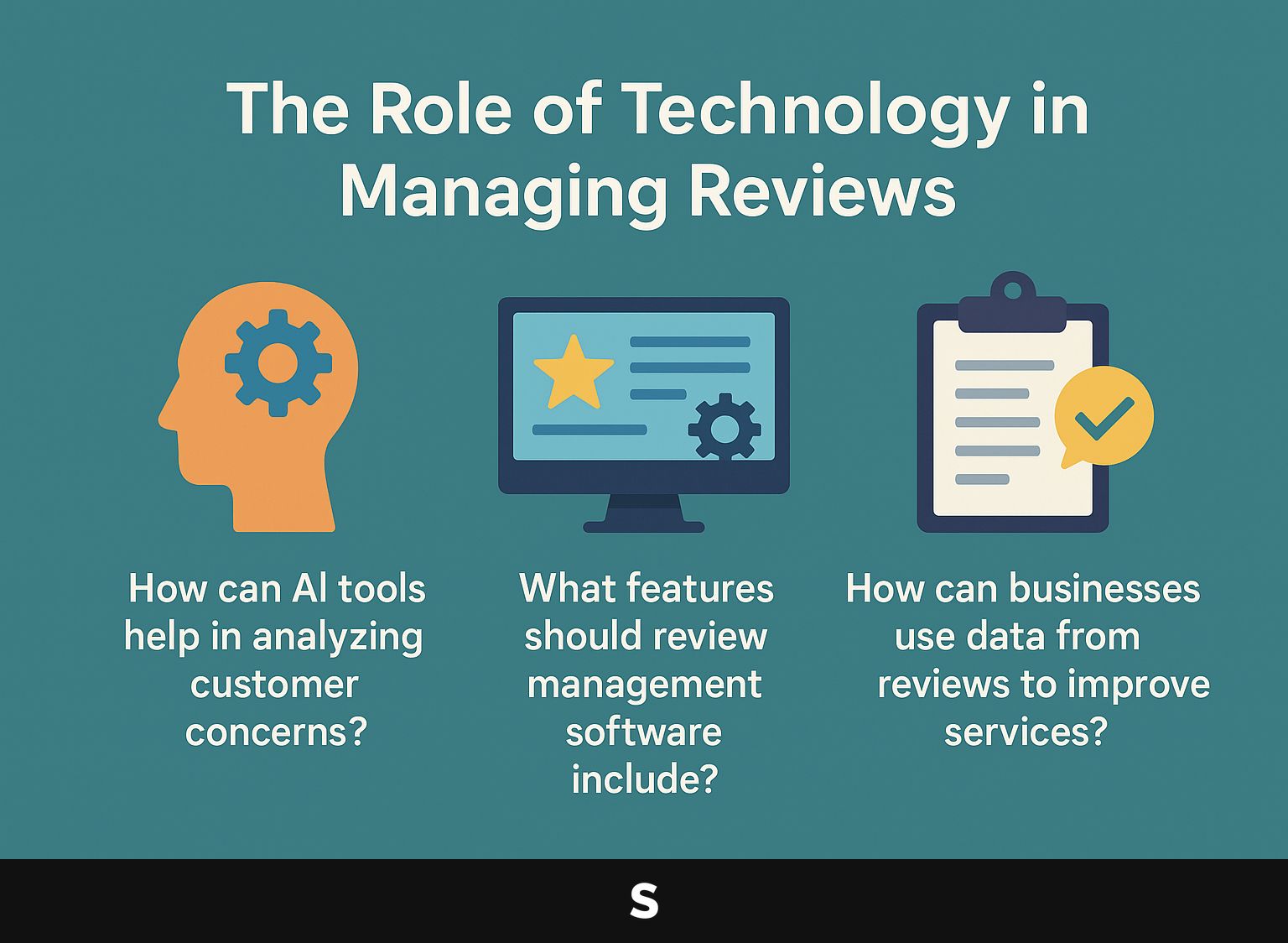
How can AI tools help in analyzing customer concerns?
AI tools, such as sentiment analysis software, help businesses understand customer concerns by categorizing feedback and identifying common themes.
To implement sentiment analysis effectively, start by selecting a tool like MonkeyLearn or Lexalytics.
First, collect customer reviews from platforms like Yelp or Amazon. Next, integrate these data sources into your chosen AI tool. For example, MonkeyLearn lets you make a sentiment analysis model that fits your needs.
After setting up, analyze the results to identify recurring themes, such as product quality or customer service issues. Use this information to improve your products and make customers happier.
What features should review management software include?
Review management software should have features like automatic reply templates, tools to analyze customer feelings, and dashboard reports to manage customer feedback effectively.
Find easy-to-use interfaces that make moving through the system simpler and work smoothly with CRM systems.
Trustpilot has strong tools for gathering reviews, while Zendesk is great for customer communication.
Also, consider features like collecting feedback from different channels to gather information from various platforms.
A mobile app makes it easier to access and respond quickly while moving.
Pick software that fits your business needs to better connect with customers and increase satisfaction.
How can businesses use data from reviews to improve services?
Businesses can use data from reviews to improve their services by spotting areas that need work based on patterns in customer feedback.
For example, a local restaurant analyzed its reviews and found consistent comments about slow service. They implemented specific actions: training staff on efficiency, re-evaluating the kitchen workflow, and incorporating a digital ordering system. Within weeks, customer ratings improved significantly.
To follow this approach, first categorize feedback into themes like service speed, menu variety, and cleanliness. Next, prioritize issues based on frequency and impact. Act on these concerns, check progress often, and change things as needed.
“Upcoming Developments in Customer Feedback and Building Trust”
New developments in technology and changes in how customers behave are set to change how customer reviews work and how trust is built.
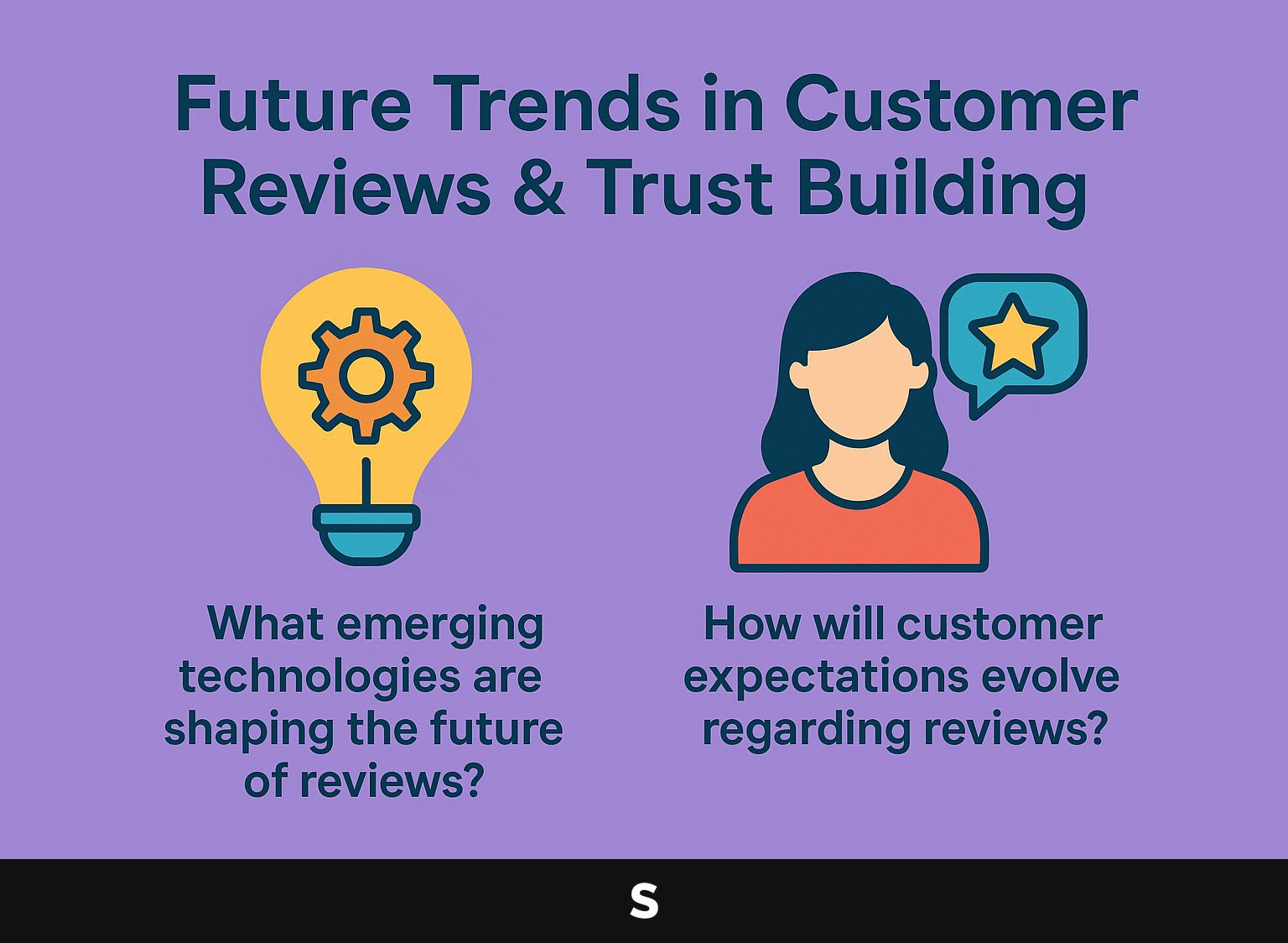
What new technologies are influencing the development of reviews?
New technologies such as blockchain and augmented reality are beginning to alter how reviews are collected, distributed, and verified, increasing their reliability.
Blockchain enables secure, tamper-proof review systems. By using platforms like Ethereum, companies can make sure that feedback stays unchanged after submission, resulting in more trustworthy information.
For example, Provenance uses blockchain to clearly show the origin of products and customer opinions about them. Augmented reality makes user experience better by allowing potential buyers to see how products would appear in their own space, helping them make more informed choices.
Businesses such as IKEA have used AR apps to improve how they connect with customers, building trust through a more engaging shopping experience.
How will customer expectations evolve regarding reviews?
As customers become more discerning, their expectations regarding the authenticity and relevance of reviews will continue to evolve.
To meet these shifting demands, businesses should consider integrating video testimonials and real-time feedback mechanisms.
Video reviews add a personal touch, allowing potential customers to see real users sharing their experiences. Utilizing tools like Trustpilot for real-time feedback can help address concerns immediately.
Adding interactive polls to your website can quickly collect feedback about how happy customers are.
By adjusting to these trends, businesses can improve their reputation and build stronger relationships with their audience.
Frequently Asked Questions
How can I use reviews to build trust with potential customers?
By addressing common customer concerns in your reviews, you can show potential customers that you understand their worries and have solutions to ease them.
How does Spokk.io’s AI understand industry-specific concerns?
Spokk.io’s AI is trained to recognize keywords and phrases specific to different industries, allowing it to understand and address common concerns in reviews.
What types of concerns can Spokk.io’s AI address in reviews?
Spokk.io’s AI can address a wide range of concerns, from the safety and security of items during a move, to the anxiety and pain experienced by patients at the dentist.
Can addressing concerns in reviews help set my business apart from competitors?
Yes, by proactively addressing common concerns through reviews, you can show potential customers that your business takes their worries seriously and has solutions to address them.
Is it important to address concerns in reviews for different industries?
Yes, different industries may have unique concerns and addressing them in reviews can help build trust with potential customers by showing that your business understands their specific needs.
How can Spokk.io’s AI help me reassure potential customers in reviews?
Spokk.io’s AI can turn common concerns into positive reviews, showcasing your business’s solutions and reassuring potential customers that their worries will be taken care of.
